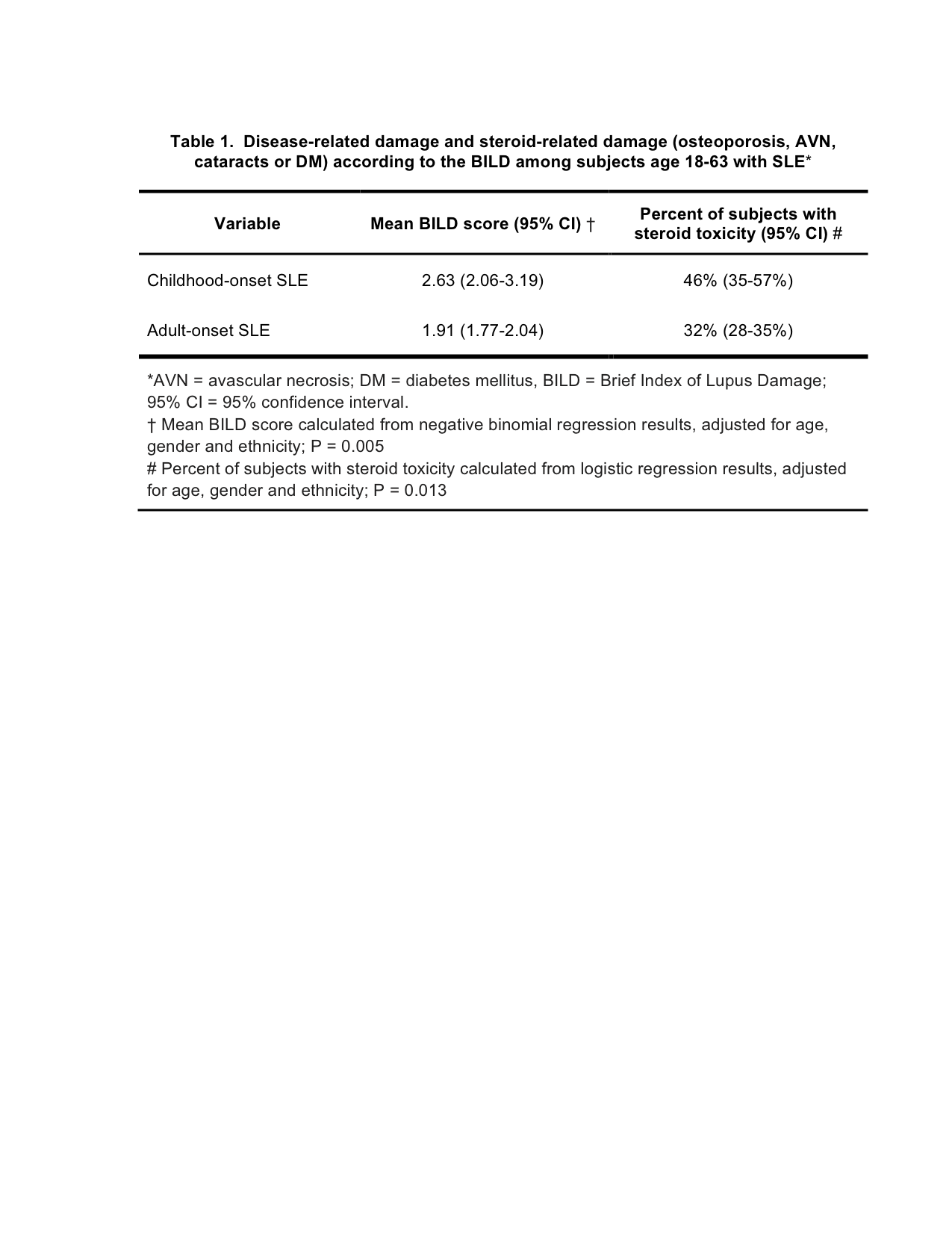Session Information
Session Type: Abstract Submissions (ACR)
Background/Purpose: While previous work has shown that adults with childhood-onset systemic lupus erythematosus (cSLE) have increased risk of mortality, renal disease and myocardial infarction as compared to individuals with adult-onset SLE (aSLE), little is known about differences in cumulative disease damage or steroid toxicity between adults with cSLE and aSLE. The goal of this study was to determine whether adults with cSLE are at increased risk for disease damage and steroid toxicity as compared to those with aSLE.
Methods: Data derive from the 2007-2011 cycles of the Lupus Outcomes Study (LOS), an annual longitudinal telephone survey of diverse English-speaking subjects with confirmed SLE. The Brief Index of Lupus Damage (BILD), a validated, patient-reported measure, was used to assess SLE-associated damage (Yazdany, 2011). Subjects age 18-63 were included in the analysis (N=823). Subjects were classified as childhood-onset if age at diagnosis was < 18 years (N=105). Outcome variables included BILD score and the presence of steroid-related damage. Steroid-related damage was defined as a self-reported history of cataracts, diabetes mellitus (DM), osteoporosis or avascular necrosis (AVN). We used negative binomial regression and logistic regression to compare cSLE and aSLE with and without adjustment for current age, gender and ethnicity. Disease duration was not included in the model due to colinearity with current age and category of age at onset.
Results: Mean age (±SD) was 46 years (±11), and 93% were female. Ethnicities included Caucasian (60%), Hispanic (10%), African American (12%), Asian (12%) and other (7%). Subjects with cSLE were more likely to be ethnic minorities (p<0.001). Mean age at diagnosis was 14 (±3) for subjects with cSLE and 33 (±10) for subjects with aSLE. Mean disease duration was 18 years (±8) for subjects with cSLE and 14 years (±10) for subjects with aSLE. Unadjusted mean BILD score was 1.8 (median 1, range 0-11) among subjects with cSLE and 2.0 (median 1, range 0-12) among subjects with aSLE. In adjusted analysis, there was greater SLE damage among subjects with cSLE (Table 1). There was no difference in unadjusted frequency of steroid-related damage (cataracts, DM, osteoporosis or AVN) between cSLE and aSLE groups (30% vs. 33%). However, in adjusted analysis, subjects with cSLE were twice as likely to report steroid toxicity as compared to subjects with aSLE (odds ratio 1.9, 95% CI 1.1-3.3).
Conclusion: In this large cohort of adults with SLE, onset of lupus in childhood predicts increased disease damage. Childhood-onset SLE also predicts increased risk of steroid-related damage, which may be due to greater cumulative steroid exposure. Tight disease control and minimization of steroid use in childhood may be important to decrease long-term morbidity in cSLE.
Disclosure:
E. F. Lawson,
None;
L. Trupin,
None;
J. Yazdany,
None;
A. Hersh,
None;
E. von Scheven,
None;
E. H. Yelin,
None.
« Back to 2012 ACR/ARHP Annual Meeting
ACR Meeting Abstracts - https://acrabstracts.org/abstract/childhood-onset-predicts-increased-disease-damage-and-steroid-toxicity-in-a-cohort-of-adults-with-systemic-lupus-erythematosus/

